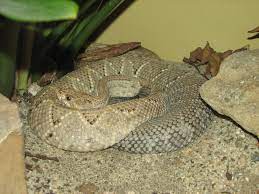(Oranjestad)—If you have ever or will ever go off-roading on the island, you may encounter the native Cascabel. Learning about the Cascabel and local perspective on it may help you understand what you need to do if you ever were to encounter one during your touring session on the island.
The small Cascabel or Aruba Island Rattlesnake averages 70 cm in length. The body color is often uniform gray or light brown. There may be a faint pattern of diamond shaped markings on the back. This pattern is most noticeable on younger snakes. The most distinctive feature of this snake is the rattle at the end of its tail which makes a buzzing sound when the snake is alarmed. Cascabels are shy and not aggressive, but their venom can be dangerous to humans. In fact, it’s the only venomous snake native to the island. It is best to leave this snake alone. Do not attempt to catch or kill it, as it could not only be dangerous, but this snake is also endemic to the island, and its preservation has become a legal mandate for all residents and visitors.
Cascabels hunt by waiting under bushes and fruiting trees to catch passing lizards, mice, rats, small rabbits, and an occasional bird. This is often considered to be one of the rarest rattlesnakes in the world. The range of the Cascabel is restricted to the rugged and mountainous areas of the island mostly within Arikok National Park. The Arikok National Park was designated in the early 1980s to include most of the rattlesnake’s population, providing a safe refuge in which the snake can be protected and monitored. The government has also implemented outreach and education initiatives to change local perception of the snake and highlight its ecological and economic importance – it is now being promoted as a national symbol. Arikok’s partnership with the Toledo zoo has safeguarded the rattlesnake ex-situ and led to a number of research projects collecting critical data on the Cascabel’s abundance, life history and habitat requirement to help guide future conservation efforts.
















